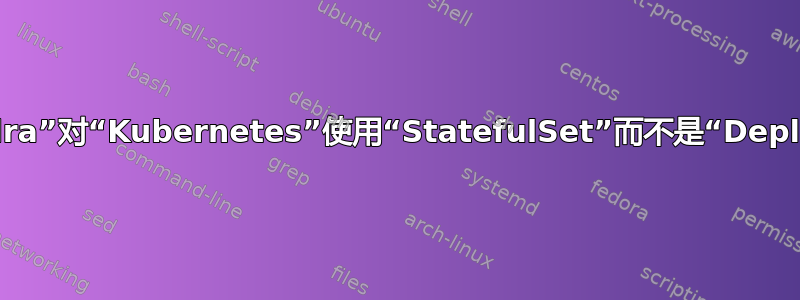
我正在尝试部署Cassandra在我运行的本地Kind集群上Ubuntu 22.04。我找到的唯一指令是这,使用 来StatefulSet表示。我只是想知道,Deployment文件不是更新的东西吗?为什么他们不使用Deployment文件而使用StatefulSet?如果使用文件更好Deployment,有人能帮我将其转换StatefulSet为Deployment文件吗?
apiVersion: apps/v1
kind: StatefulSet
metadata:
name: cassandra
labels:
app: cassandra
spec:
serviceName: cassandra
replicas: 3
selector:
matchLabels:
app: cassandra
template:
metadata:
labels:
app: cassandra
spec:
terminationGracePeriodSeconds: 1800
containers:
- name: cassandra
image: gcr.io/google-samples/cassandra:v13
imagePullPolicy: Always
ports:
- containerPort: 7000
name: intra-node
- containerPort: 7001
name: tls-intra-node
- containerPort: 7199
name: jmx
- containerPort: 9042
name: cql
resources:
limits:
cpu: "500m"
memory: 1Gi
requests:
cpu: "500m"
memory: 1Gi
securityContext:
capabilities:
add:
- IPC_LOCK
lifecycle:
preStop:
exec:
command:
- /bin/sh
- -c
- nodetool drain
env:
- name: MAX_HEAP_SIZE
value: 512M
- name: HEAP_NEWSIZE
value: 100M
- name: CASSANDRA_SEEDS
value: "cassandra-0.cassandra.default.svc.cluster.local"
- name: CASSANDRA_CLUSTER_NAME
value: "K8Demo"
- name: CASSANDRA_DC
value: "DC1-K8Demo"
- name: CASSANDRA_RACK
value: "Rack1-K8Demo"
- name: POD_IP
valueFrom:
fieldRef:
fieldPath: status.podIP
readinessProbe:
exec:
command:
- /bin/bash
- -c
- /ready-probe.sh
initialDelaySeconds: 15
timeoutSeconds: 5
# These volume mounts are persistent. They are like inline claims,
# but not exactly because the names need to match exactly one of
# the stateful pod volumes.
volumeMounts:
- name: cassandra-data
mountPath: /cassandra_data
# These are converted to volume claims by the controller
# and mounted at the paths mentioned above.
# do not use these in production until ssd GCEPersistentDisk or other
# ssd pd
volumeClaimTemplates:
- metadata:
name: cassandra-data
spec:
accessModes: [ "ReadWriteOnce" ]
storageClassName: fast
resources:
requests:
storage: 1Gi
---
kind: StorageClass
apiVersion: storage.k8s.io/v1
metadata:
name: fast
provisioner: k8s.io/minikube-hostpath
parameters:
type: pd-ssd
答案1
AStatefulSet不同于 aDeployment。从文档:
与 Deployment 类似,StatefulSet 管理基于相同容器规范的 Pod。与 Deployment 不同,StatefulSet 为每个 Pod 维护一个固定身份。这些 Pod 是根据相同规范创建的,但不可互换:每个 Pod 都有一个持久标识符,该标识符在任何重新调度后都会保留。
当你的 Pod 需要维护某种唯一状态时,可以使用 StatefulSet —— 例如,volumeClaimTemplates清单的部分意味着每个 Pod 都会获得一个唯一的PersistentVolumeClaim。使用 则无法实现这一点Deployment。
一般来说,除非您只打算拥有一个副本,否则不能将 a 转换StatefulSet为 a 。Deployment


